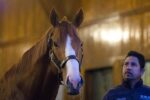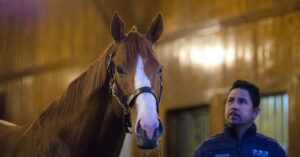No one should be surprised at Japan’s development into a powerful racing force. It has taken decades of cultivation, foresight and determination, encompassing numerous acquisitions of stallions and broodmares alongside an increased understanding of management and training. Like any endeavour, there have been bumps in the road – some of those Derby winners imported during the 1990s won’t be remembered fondly by Japanese breeders – but any disappointments have also been offset many times over by the success of various others, none more so than Sunday Silence.
Today’s breed is one where the middle-distance horse is celebrated and longevity a requisite. Breeders tend to produce as such, which places the emphasis on breeding for the racecourse rather than the sale ring, an alien concept for some in Europe and North America.
“The focus is on middle-distance horses, those 1m2f to 1m4f horses because over there, if you really want to get into the sport, those Classic types are what’s needed,” bloodstock agent John Tyrrell said in a feature with Owner Breeder last year. “It really is the kind of racing product that we dream about having over here – they have the stallions, they have the mares, they have the facilities and then at the end of it they are also racing for excellent prize-money.”
So as ever, a lot of it boils down to prize-money. Align that with a deep and enthusiastic fan base alongside a desire to compete globally and is it any wonder that Japanese-bred and trained horses are dominating some of the big international meetings?
“They have the stallions, they have the mares, they have the facilities and then at the end of it they are also racing for excellent prize-money”
There was the Breeders’ Cup at Del Mar in November 2021 where trainer Yoshito Yahagi saddled Marche Lorraine to spring a 50/1 upset in the Distaff and Loves Only You to win the Filly & Mare Turf ahead of a successful swansong in the Hong Kong Cup at Sha Tin.
Saudi Arabia has also come to be a happy hunting ground, yielding four winners – Authority, Lauda Lion, Stay Foolish and Dancing Prince – in 2022 and another three – Bathrat Leon, Silver Sonic and Panthalassa – in 2023.
Yet it is Dubai where the nation consistently really shines. Their success at the Dubai World Cup meeting is nothing new – think Victoire Pisa, Almond Eye, Stay Gold and Just A Way among others – and the 2022 meeting took matters to a new level with Bathrat Leon capturing the Godolphin Mile, Stay Foolish following up his Saudi success by landing the Dubai Gold Cup, Crown Pride scoring in the UAE Derby, Panthalassa dead-heating for victory in the Dubai Turf and Shahryar winning the Dubai Sheema Classic.
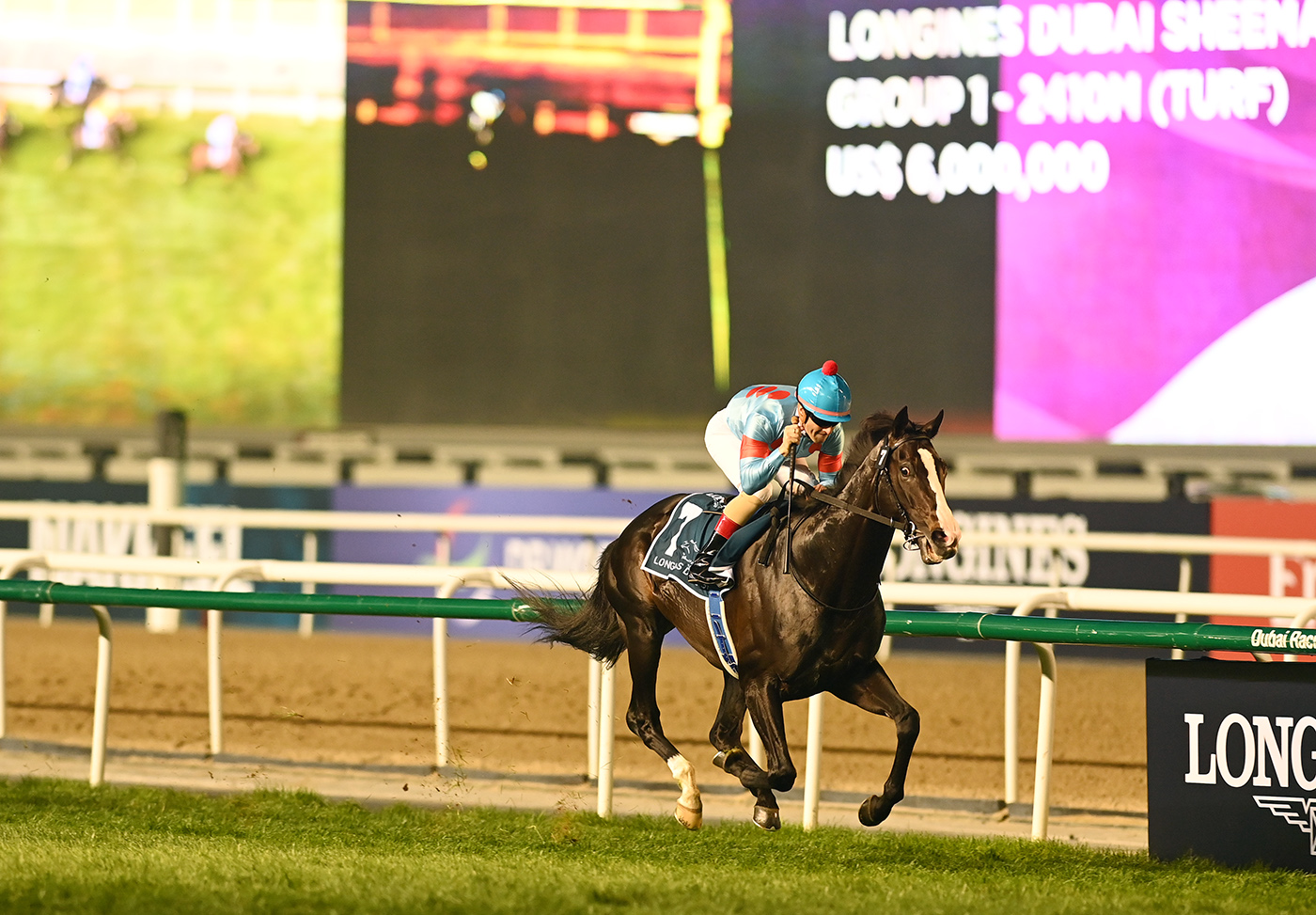
Equinox, partnered by Christophe Lemaire, smashes the track record in a stunning display in the Dubai Sheema Classic. Photo – Bill Selwyn
Unsurprisingly, Japanese connections returned this year with another impressive battalion and while not as numerically successful as 12 months earlier, did land three of the evening’s races.
What is more, each were performances that will live long in the memory. Derma Sotogake, from the first crop of the top American sprinter Mind Your Biscuits, made all to lead home a Japanese 1-2-3-4 in the UAE Derby and set himself up for a crack at the Kentucky Derby. Equinox never came off the bridle to win the Dubai Sheema Classic while the Noboru Takagi-trained Ushba Tesoro came from the clouds to run down Algiers in the Dubai World Cup.
Meydan was the scene of some exceptional performances on Saturday, including Lord North’s third straight win in the Dubai Turf. But without doubt, the most brilliant of all belonged to Equinox. Comfortable wins over Panthalassa in last year’s Tenno Sho (Autumn) and the likes of Titleholder and Efforia in the Arima Kinen had propelled the Tetsuya Kimura-trained four-year-old to a rating of 126 during 2022. Saturday’s race was meant to provide a stern test on paper, consisting of the winners of the Irish Derby, Hong Kong Vase, Breeders’ Cup Turf, Champions & Chater Cup and last year’s Sheema Classic. But confidence in Equinox was nevertheless high, leading him to go off the even-money favourite, and he duly destroyed them, lowering Mishriff’s track record by exactly a second to 2:26.65 despite being eased down by Christophe Lemaire in the closing stages.
The $17,000 yearling that changed a racing nation
Bred by Katsumi Yoshida’s Northern Farm, Equinox is yet another reminder of the debt Japanese racing owes to Sunday Silence. He is a direct descendant of the Japanese supersire, three generations removed via his sire Kitasan Black and grandsire Black Tide. Despite the generational gap, the angular, leggy, dark-coloured Equinox is still very much in that Sunday Silence mould – just like Kitasan Black and Black Tide before him.
It is well known how Sunday Silence failed to sell for $17,000 as a yearling and $32,000 as a two-year-old. By the time he joined Charlie Whittingham’s barn in California, he had also skirted death on several occasions, once when contracting a bug as a young foal and then as a two-year-old when involved in a serious van accident that killed several of its load.
“At the end of the day, I had two contracts and three shares sold. The day he left, I loaded him up myself and I don’t mind admitting that when that van went down the drive, I cried”
As recalled by Arthur Hancock of Stone Farm in Kentucky, there were a mental toughness to the horse that stood him in good stead. Stone Farm raised Sunday Silence and stood his sire Halo, and I was lucky enough to chat to Hancock for a feature on the horse on behalf of Trainer magazine.
“He was Halo’s son, that’s for sure, because his dam Wishing Well was a nice mare,” recalled Hancock. “Sunday Silence had a mind of his own, even as a yearling – I remember we couldn’t get him to walk well at the sales because he’d pull back against the bit all the time.
“When he came back here after his racing days, we had a photographer come to take some shots. Sunday Silence was in his paddock and we were trying to get him to raise his head. I went in there and shook a branch to get his attention. Well, he looked up, bared his teeth and started to come after me – he was moving at me head down like a cat. And I said ‘no you’re ok there boy, you just continue to graze’ and let him be.”
It had been left to Hancock to send Sunday Silence to the track following his unsuccessful trips through the ring, and what a silver lining that turned out to be, with the horse going on to win the 1989 Kentucky Derby, Preakness Stakes and Breeders’ Cup Classic during the course of a memorable East-West rivalry with Easy Goer.
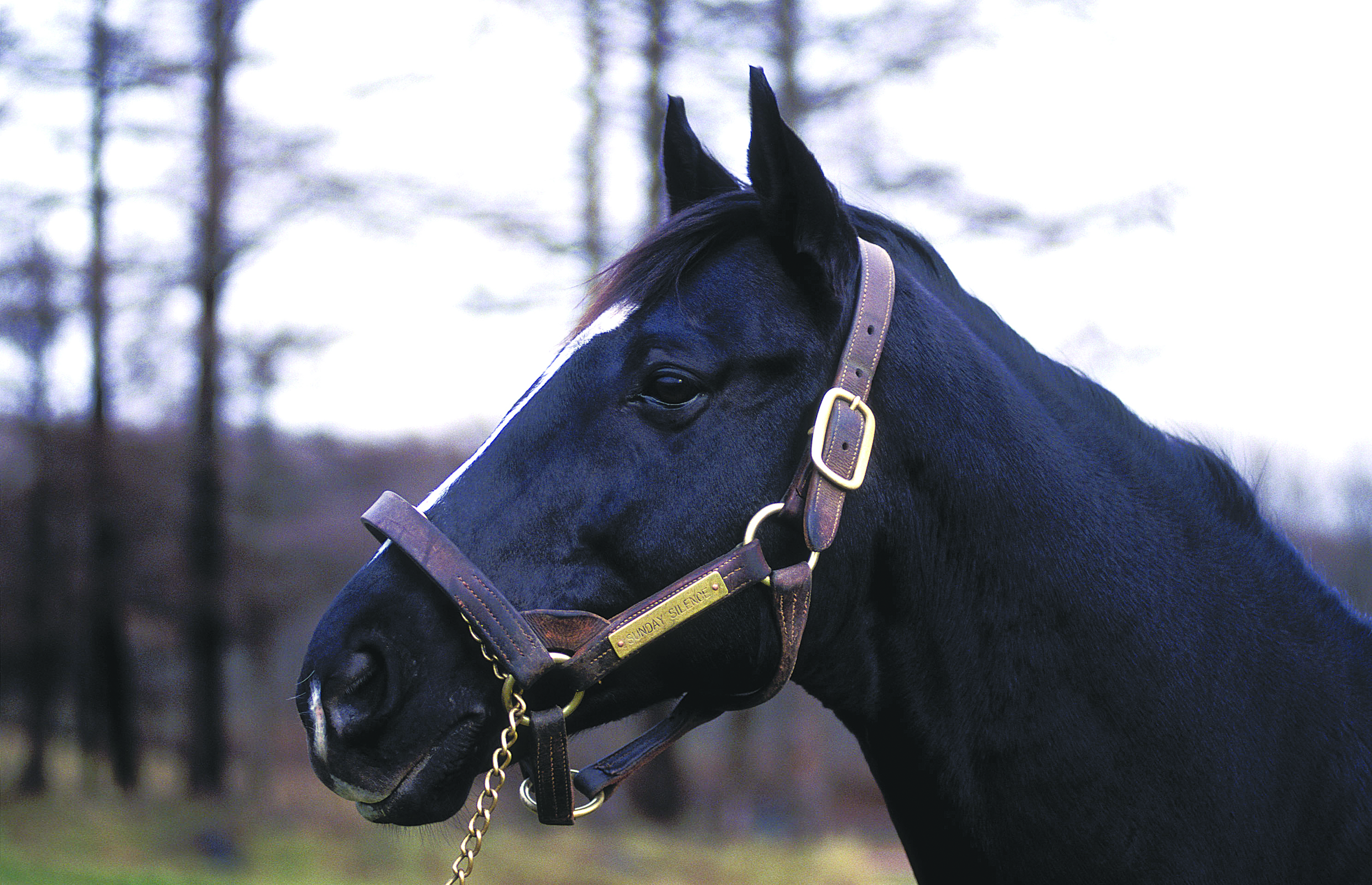
Sunday Silence: altered the course of Japanese racing history. Photo – Trevor Jones
It is a fine reflection of Whittingham and his staff, in particular work rider Pam Mabes, that Sunday Silence’s temperament was successfully honed; in Jay Hovdey’s biography of the trainer, the colt is likened to ‘Al Capone singing with the Vienna Boys Choir’, his morning exercise routinely punctuated by bad behaviour.
When Hancock came to standing his Classic winner, however, Kentucky was unreceptive.
“We tried to syndicate him and called people everywhere – Kentucky, England, France and the answer was always the same,” recalled Hancock in Trainer. “It became apparent very quickly that people wouldn’t use him. It was spread around the industry that he was a fluke, another Seabiscuit or Citation who could run but that would be no good at stud. It was said that he was crooked, which he wasn’t, and that he was sickle hocked, which he was as a young horse but grew out of. He was an ugly duckling that grew into a swan.
“We had three people on the books to take shares and two that would send mares. Then I spoke to my brother Seth at Claiborne and he had 40 contracts to send out for Easy Goer.
“At the same time, I got a call from a representative of Teruya Yoshida saying that Shadai would be interested in buying the whole horse. They were offering $250,000 per share. At the end of the day, I had two contracts and three shares sold. The day he left, I loaded him up myself and I don’t mind admitting that when that van went down the drive, I cried.
“Basically the Japanese outsmarted everybody.”
Sunday Silence was no oil painting and indeed some of those physical traits can still manifest themselves in his descendants. But handsome is as handsome does, and horses from that line also often possess an abundance of physical and mental toughness.
As the Group 1 winners started to pile up on his stud record, Europe slowly switched on, especially Sheikh Mohammed, whose early interest in the stallion was rewarded by the Classic-placed Sundrop and Cherry Hinton Stakes winner Silent Honor. By contrast, his best son Deep Impact attracted international attention from the moment he was retired to stand at the Shadai Stallion Station, and when the Wildenstein family was vindicated for their support by breeding Poule d’Essai des Pouliches heroine Beauty Parlour out of his second crop, that naturally opened the floodgates for Deep Impact to become a more regular presence in Europe; the likes of Saxon Warrior, Study Of Man, Auguste Rodin, Snowfall, Fancy Blue and September have since followed.
A hugely admirable horse who was Japan’s Horse of the Year and a two-time Champion Older Male, Kitasan Black was a typically tough Japanese product who won 12 of his 20 starts
We have become accustomed to Japan’s international influence hinging on Deep Impact, or at times to the fellow Sunday Silence stallion Heart’s Cry. But Equinox is not one such horse, instead descending from Deep Impact’s full-brother Black Tide. Both are out of Wind In Her Hair, a daughter of Alzao trained by John Hills to run second to Balanchine in the 1994 Oaks and who is still going strong at 32-years-old as a pensioner at the Northern Horse Park.
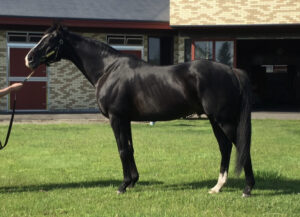
Black Tide: brother to Deep Impact is the grandsire of Equinox
Black Tide, who bears a particularly close physical resemblance to Sunday Silence, was nowhere near as talented as Deep Impact, winning three of 22 starts over the course of six seasons headed by a Listed event over 1,800 metres. Presumably his pedigree was a key factor in his early popularity with breeders that featured six-figure books in each of his first nine seasons (he covered 194 mares in 2015). In return, he has had his moments at stud as the sire of 11 stakes winners. Now 22-years-old, he is standing this season for 1,500,000yen (£9,300) at his long-term home of the Breeders’ Stallion Station in Japan.
Kitasan Black is by far the best sired to date by Black Tide. A hugely admirable horse who was Japan’s Horse of the Year and a two-time Champion Older Male, he was a typically tough Japanese product who won 12 of his 20 starts highlighted by the Kyoto Kikuka Sho at three, Japan Cup and Tenno Sho at four, and the Arima Kinen, Osaka Hai, Tenno Sho (Spring) and Tenno Sho (Autumn) at five.
Early success
Kitasan Black’s first two crops number 84 and 82 foals, so he doesn’t have vast numbers on the ground. But the quality is understandably there, as illustrated by the fact that his first two books included the progeny of Group 1-winning producers such as Donna Blini (resulting colt sold for $1,454,546) and Malacostumbrada (colt sold for $1,775,701) in addition to July Cup heroine Fleeting Spirit (colt sold for $1,028,038) and Japanese Oaks heroine Erin Court.
Equinox, a son of the Group 3-winning King Halo mare Chateau Blanche, is from his first crop, also the source of Group 2 winner Gaia Force and Listed scorer Justin Sky. Group 3 winners Ravel and Sol Oriens, who is unbeaten in two starts and could be anything, are the highlights of 21 winners so far from his second crop. It’s a fine start and one that has prompted the Shadai Stallion Station to raise his fee from 4,000,000yen (£25,000) to 10,000,000yen (£62,500) for this season.
Even at this early stage, several interesting patterns are emerging. While it is hard to escape Sunday Silence blood in Japan, inbreeding to the great horse hasn’t always been regarded as desirable. Even so, five of Kitasan Black’s nine stakes horses carry double doses of Sunday Silence, including Gaia Force and Ravel. While Equinox isn’t one of them, he is inbred 4×4 to his sire Halo.
Dancing Brave’s presence also provides another line of Lyphard, to whom Kitasan Black is also inbred
Equinox’s damsire, the Group 1 Takamatsunomiya Kinen winner King Halo, was a son of Dancing Brave, that brilliant performer of 1986 whose sale to Japan in the early 90s was swiftly followed by the 1993 Classic successes of Commander In Chief, White Muzzle and Wemyss Bight. Interestingly, Dancing Brave also appears in the background of Kitasan Black’s Group 3-placed daughter Bijou Noir, out of a mare by White Muzzle. Dancing Brave’s presence also provides another line of Lyphard, to whom Kitasan Black is also inbred; inbreeding to the diminutive son of Northern Dancer can also be found in the background of seven of Deep Impact’s Group 1 winners, including Gentildonna, Deep Brillante and Glory Vase.
Kitasan Black has also forged a fine partnership with mares carrying the Deputy Minister horse French Deputy; he features in the pedigrees of four of his stakes horses including Ravel while his successful sire son Kurofune is the damsire of Gaia Force.
It is coming up to four years since Deep Impact died. No Japanese-based stallion has since come close to commanding the same level of international attention, for all that Lord Kanaloa has long been highly successful and could have a smart one at Ballydoyle this season in Beginnings. However, perhaps Kitasan Black is the horse who could one day fill that void. Yes, it’s early days and he has to build on the success of his first crops, but in Equinox, the best horse in the world, it’s a pretty good start.
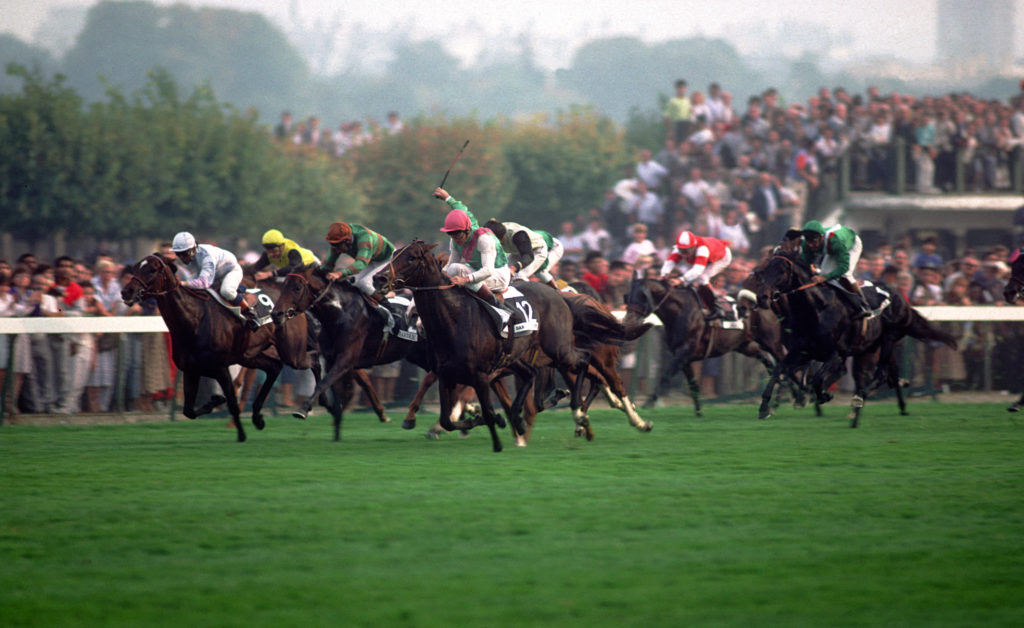
Dancing Brave: brilliant performer appears in the background of Equinox. Photo – George Selwyn


